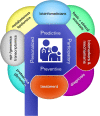The role of the clinician in the multi-omics era: are you ready?
- PMID: 29362952
- PMCID: PMC5959952
- DOI: 10.1007/s10545-017-0128-1
The role of the clinician in the multi-omics era: are you ready?
Abstract
Since Garrod's first description of alkaptonuria in 1902, and newborn screening for phenylketonuria introduced in the 1960s, P4 medicine (preventive, predictive, personalized, and participatory) has been a reality for the clinician serving patients with inherited metabolic diseases. The era of high-throughput technologies promises to accelerate its scale dramatically. Genomics, transcriptomics, epigenomics, proteomics, glycomics, metabolomics, and lipidomics offer an amazing opportunity for holistic investigation and contextual pathophysiologic understanding of inherited metabolic diseases for precise diagnosis and tailored treatment. While each of the -omics technologies is important to systems biology, some are more mature than others. Exome sequencing is emerging as a reimbursed test in clinics around the world, and untargeted metabolomics has the potential to serve as a single biochemical testing platform. The challenge lies in the integration and cautious interpretation of these big data, with translation into clinically meaningful information and/or action for our patients. A daunting but exciting task for the clinician; we provide clinical cases to illustrate the importance of his/her role as the connector between physicians, laboratory experts and researchers in the basic, computer, and clinical sciences. Open collaborations, data sharing, functional assays, and model organisms play a key role in the validation of -omics discoveries. Having all the right expertise at the table when discussing the diagnostic approach and individualized management plan according to the information yielded by -omics investigations (e.g., actionable mutations, novel therapeutic interventions), is the stepping stone of P4 medicine. Patient participation and the adjustment of the medical team's plan to his/her and the family's wishes most certainly is the capstone. Are you ready?
Keywords: Diagnosis; Genomics; Inherited metabolic disease; Metabolomics; Precision medicine; Treatment.
Conflict of interest statement
Clara van Karnebeek, Saskia Wortmann, Maja Tarailo-Graovac, Mirjam Langeveld, Carlos Ferreira, Jiddeke van de Kamp, Carla Hollak, Wyeth Wasserman, Hans Waterham, Ron Wevers, Tobias Haack, Ronald Wanders, and Kym Boycott declare that they have no conflict of interest in relation to the current work.
Figures


References
Publication types
MeSH terms
LinkOut - more resources
Full Text Sources
Other Literature Sources

